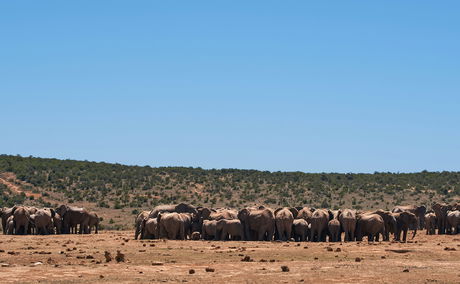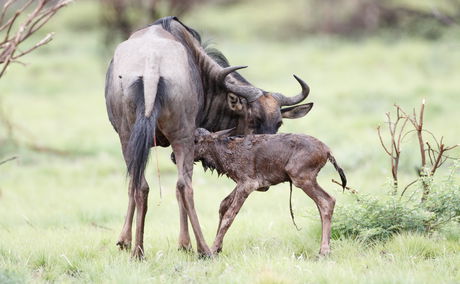Discover the fascinating survival strategy of elephant herds—bunching behavior. From protecting calves against predators to symbolizing deep family bonds, bunching showcases the intelligence and unity of elephants. However, threats like poaching and habitat loss disrupt these vital instincts, underscoring the need for conservation. Explore these majestic creatures with Kijani Tours and witness their intricate social dynamics firsthand. Embrace responsible tourism and connect with the heart of nature's narrative.
Navigating Peril: River Crossings as Critical Moments in wildebeest Migration
The Great Migration is a breathtaking event in nature, with over 1.5 million wildebeests, zebras, and gazelles traversing the Serengeti-Mara ecosystem. Each year, these animals confront the perilous Mara River, home to hungry crocodiles, where hesitation mixes fear with survival instinct. The migration is driven by seasonal rains that dictate grazing availability, underscoring the delicate balance of the ecosystem, with predators like lions playing a crucial role in this dynamic. As wildebeests face the strong currents and rocky terrain to reach safety, their resilience exemplifies the essence of survival in the wild. Observing this migration between July and October is a transformative experience, but it's essential to engage respectfully with nature by following ethical safari practices. Ultimately, participating in a safari fosters a deep connection with the wilderness, offering insights into the intricate relationships that sustain all life within this remarkable ecosystem.
River Crossings: Life-or-Death Decisions in the Great Migration
Imagine standing at the edge of a vast riverbank, where thousands of wildebeests gather, their excitement mixed with hesitation. Before them lies the Grumeti and Mara Rivers, an imposing obstacle in their quest for survival. Below the surface, crocodiles lurk, eagerly anticipating the thrilling spectacle that unfolds during the migration. For these noble creatures, crossing the river is not merely a matter of reaching the other side; it is a gripping life-or-death gamble. Experiencing this breathtaking moment of nature on safari is truly unforgettable.

The Great Migration: Nature’s Ultimate Journey
The Great Migration stands out as one of the most astonishing natural events on our planet. Each year, more than 1.5 million wildebeests, along with hundreds of thousands of zebras and gazelles, embark on a remarkable trek across the Serengeti-Mara ecosystem. This incredible journey weaves through Tanzania’s Serengeti National Park and Kenya’s Masai Mara Reserve, meticulously following the rhythm of seasonal rains and the search for fresh grazing grounds. But this migration is more than just a trek; it's a relentless struggle for survival.
In February and March, vulnerable calves are born in Ndutu, southern Serengeti, just as predators like lions, leopards, cheetahs, and hyenas are on the prowl, ready to seize the opportunity. By July, as the journey reaches its pinnacle, the herds confront their greatest challenge—crossing the river. Here, the tension escalates; with hungry crocodiles lurking and powerful currents ready to sweep away those who falter, the stakes have never been higher. This mesmerizing spectacle is a true testament to the resilience and determination of wildlife in their never-ending quest for survival.
The Fascinating Journey of Migration
The Great Migration is a remarkable journey driven by the instincts of countless animals. Seasonal rains dictate when and where fresh grazing lands will appear, prompting the herds to track these life-giving resources. As the rains dwindle, waterholes dry up and grass becomes limited, initiating their migration to greener pastures. This age-old cycle of survival illustrates the intricate balance of nature that has stood the test of time.
The Importance of Predators in the Serengeti-Mara Ecosystem.
In the Serengeti-Mara ecosystem, predators play a vital role. Animals like lions, leopards, cheetahs, hyenas, and crocodiles prey on the migrating herds, helping to keep populations in check. By targeting the weaker and more vulnerable members of the herds, these predators contribute to a healthier gene pool, fostering the survival of the fittest. While the migration presents a feast for predators, it also serves as an intense trial for the prey, testing their endurance and resolve.

The Mara River Crossing: A Thrilling Survival Challenge
One of the most dramatic highlights of the migration is the crossing of the Mara River. As herds assemble along the riverbanks, a mixture of apprehension and determination fills the air. The river thunders with strong currents, and elusive crocodiles lie in wait, adding to the suspense. In a remarkable display of collective bravery, the first animals leap into the water, encouraging others to follow in their quest for survival. This breathtaking moment truly showcases the courage and resilience of these incredible creatures.
Facing Tough Choices at the Riverbank
As the wildebeests gather at the riverbank, a sense of uncertainty fills the air. They pace back and forth, weighing their options, unsure of when to take the leap. Suddenly, one courageous wildebeest steps forward—a true leader who inspires the rest to follow suit. It’s a critical moment; waiting too long raises the threat of predators lurking nearby, while jumping in too soon carries its own set of dangers. This instinctual decision is nothing short of monumental—survival hinges on the ability to act at just the right moment.

The Nile Crocodile: Nature's Fearsome Hunter
Enter the Nile crocodile, an extraordinary master of stealth and patience. These formidable reptiles position themselves for weeks, knowing that the annual migration will soon deliver a banquet right to their doorstep. Weighing in at over 1,500 pounds, with an unmatched bite force, they lie in wait for wildebeests and zebras as they navigate the river's currents. The pandemonium of the crossing becomes the crocodile’s playground, allowing it to seize opportunities with swift and decisive strikes that pull their prey underwater, effectively rendering it helpless.

The Challenge of the Current: An Added Obstacle
But it’s not just the crocodiles that pose a threat—the river itself is a force to be reckoned with! The powerful currents churn against sharp rocks, creating dangerous conditions that put the herds to the ultimate test. As fatigue sets in and panic rises, even the nimblest among them can stumble, particularly the small calves who face a heightened risk. The river demands every ounce of strength and resolve from the wildebeests, making their journey one of both physical and mental endurance. Let’s marvel at the bravery and resilience of these magnificent creatures as they navigate one of nature’s most perilous crossings.

Moments of Triumph: Survival Stories
In the face of peril, the determination of these animals truly stands out. Picture calves scampering alongside their mothers and adults skillfully vaulting over barriers; it’s fascinating to witness how many wildebeests navigate the treacherous crossing, defying all odds. Their relentless drive embodies the essence of survival, offering a remarkable glimpse into the resilience of nature.
Experiencing the Great Migration: An Unforgettable Safari
There is something truly magical about witnessing a river crossing during the great migration. The palpable energy, the thrill of the moment, and the breathtaking spectacle of wildlife in action create a lasting impression that few experiences can match. To make the most of your safari adventure, it is essential to learn about the best times and locations to witness this natural phenomenon, as well as how to engage with it in a responsible and respectful way. With the right planning, you can immerse yourself in this incredible journey and create memories that will last a lifetime.
The Best Times and Places to Witness the Migration
Have you ever wondered when the breathtaking spectacle of migration takes place? The Mara River crossings are a sight to behold, typically occurring from July to October. This is undoubtedly the prime time for adventurers seeking to experience this awe-inspiring event. The northern Serengeti in Tanzania and the renowned Masai Mara in Kenya offer unparalleled views of the migration, putting you right in the heart of the action.
To make the most of your experience, we will book lodges or mobile camps well in advance—ideally a year ahead. This strategic planning not only places you close to the natural wonders but also helps you avoid the crowds, allowing for a truly immersive adventure.
Ethical Safari Tips: Respecting Wildlife and the Ecosystem
When observing the incredible spectacle of migration, it’s important to approach the experience with care to protect these remarkable creatures and their environment. Here are some thoughtful tips to enhance your adventure while minimizing human impact:
1) Stay quiet: A hushed voice can do wonders; maintaining a quiet atmosphere helps prevent startling the animals.
2) Maintain a respectful distance: Observing from afar not only keeps the herds calm but also allows you to capture breathtaking views without interruptions.
3) Avoid littering: To help preserve the beautiful ecosystem for future generations, ensure you dispose of any waste responsibly and tread lightly.
4) Follow your guide’s instructions: Your guide is a wealth of knowledge, skilled in both the safety of the wildlife and your own enjoyment—following their lead will enrich your experience.
What Makes the Wildebeest River Crossing Serengeti Safari Unforgettable?
It’s more than just a safari—it’s an awe-inspiring moment when life itself takes center stage. Picture the thunderous sound of hooves as thousands of wildebeests surge forward, their collective determination etched into the heart of the Serengeti. The primal intensity of the river crossing is a breathtaking spectacle of survival and instinct. Guided by Kijani Tours’ seasoned experts, you will uncover the delicate choreography behind this natural drama—the interplay of predators and prey, the environmental cues guiding the herds, and the deep connection between these animals and the ecosystem they sustain. Ready to witness the untamed spirit of Tanzania?
Conclusion
The Great Migration stands as one of nature’s most remarkable phenomena, with the crossings at the Mara River representing its most intense and dramatic moments. These pivotal events, where survival hangs in the balance, highlight the strength and resilience of wildebeests and the ecosystems they support. Experiencing this migration firsthand transcends mere travel; it offers a unique opportunity to appreciate the intricate beauty and raw power inherent in the natural world. For those looking to enhance their connection to nature, this journey is indispensable.
Unlock More Insights
Facts About Mount Kilimanjaro takes readers on an inspiring journey into the wonders of this iconic peak. As the world's tallest free-standing mountain, Kilimanjaro captivates with its towering height of 5,895 meters and unique volcanic cones—Kibo, Mawenzi, and Shira. The mountain's diverse ecosystems showcase five climate zones, from lush rainforests to icy arctic conditions, supporting rich biodiversity and endemic species. The melting glaciers highlight the urgent impact of climate change, while Kilimanjaro's...
The Serengeti-Mara ecosystem in Northern Tanzania and Southwestern Kenya is home to the spectacular Great Migration of wildebeests, an awe-inspiring journey of over 650 km each year! Starting from the Masai Mara and ending in Ndutu during the calving season, this migration is a breathtaking natural event that enriches the entire ecosystem. As wildebeests graze on grass, they fertilize the soil and support a rich diversity of life while preventing overgrazing. Their...



Share This Post